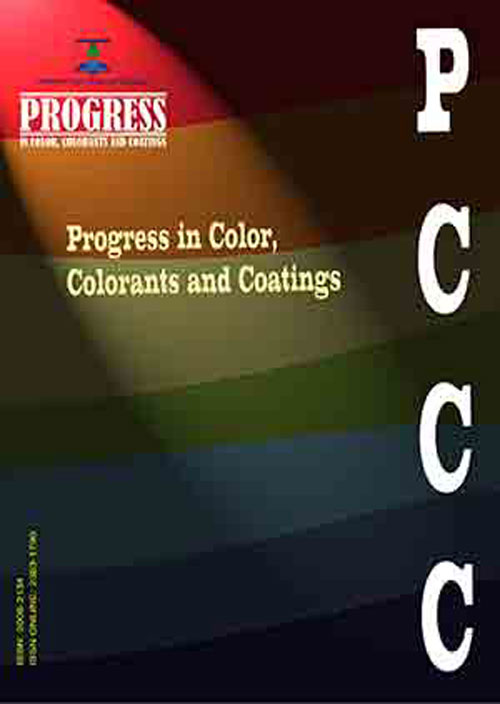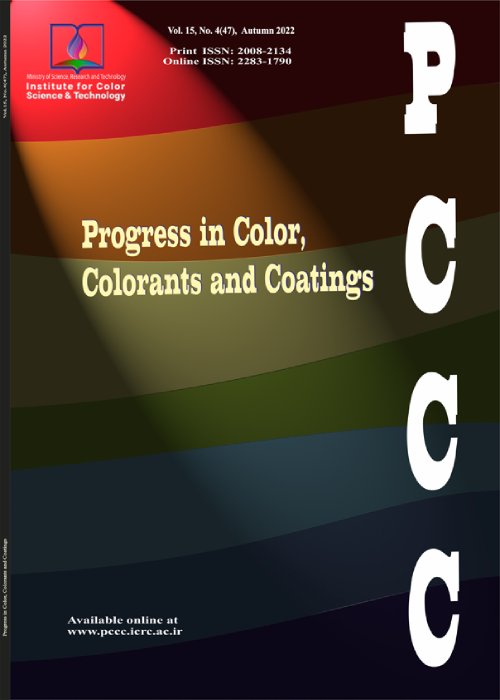فهرست مطالب

Progress in Color, Colorants and Coatings
Volume:15 Issue: 1, Winter 2022
- تاریخ انتشار: 1400/02/21
- تعداد عناوین: 7
-
-
Pages 1-9
In this study, a heat resistant coating with thermal barrier property was designed. Two types of silicone resin (based on methoxy methyl polysiloxane and methyl phenyl silicone resin) were used as thermal resistant binders, and the black iron oxide pigment and glass micro hollow sphere (MHS) additive were utilized to formulate the heat resistant/thermal barrier coatings. Coatings were applied to the steel substrates, and general properties of the coatings such as film formation, curing, and adhesion were then studied. The thermal stability of the coatings was evaluated by thermogravimetric analysis up to 450 °C. The thermal conductivity coefficient of the coatings was measured by temperature modulated differential scanning colorimeter (TMDSC). Investigation of the properties of all coatings showed that the silicone coating with the 7% of hollow microsphere had higher thermal stability (Tmaximum weight loss= 538 °C) and better barrier properties (Thermal conductivity= 0.29 W/mK (compared with other coatings.
Keywords: Heat-resistant coating, Hollow glass microsphere, Silicon coating, Thermal, conductivity coefficient, TMDSC -
Pages 11-19
In the present study, the corrosion protective ability of the sol-gel based composite coatings containing two-different types of the cationic/anionic based inhibitors loaded containers. For this purpose, the NaY zeolite and Zn-Al Layered double hydroxides (LDHs) containers were loaded with Ce3+ cations and 2- mercaptobenzothiazole (MBT) separately. The morphology and composition of the constructed micro/nanocontainers were studied using analytical methods, confirming the successful loading of the inhibitors. In this study, the Ce3+/MBT inhibitors were successfully introduced into the LDH/NaY-based zeolite containers.Results evidenced that the combination of the two inhibitors has a constructive effect on the active protection of the AA2024-T3 sheets. SEM micrographs of the unfilled LDH and stupefaction with MBT show that the prepared LDHs have sheet-like morphology. The addition of single-inhibitor filled containers to the sol-gel hybrid coating, and water-based epoxy coating provided active protection for the AA2024-T3 coated substrate. However, the combination of the filled containers with the inhibitor in the above-mentioned coatings resulted in the improvement of the active protection of the substrate, which confirms the synergy between the particles. The NaY containers loaded with the Ce3+ resulted in a significant increase of the |Z|0.01 Hz of the gel-sol hybrid coatings, which indicates the formation of a stable oxide layer with higher resistance. Whereas the |Z|0.01 Hz of the hybrid sol-gel coatings loaded with LDH-MBT were in the same range as the NaY-Ce loaded coatings, containing NaY-Ce and LDH-MBT, showed the highest |Z|0.01 Hz values that indicate the synergy between the inorganic (Ce3+) and organic (MBT) inhibitors in sol-gel hybrid coatings.
Keywords: corrosion, Self-healing, Nano-containers, Inhibitors, Layered double hydroxides (LDHs), EIS -
Pages 21-33Novel modified coumarin bearing thiosemicarbazide pendant moiety prepared by the reaction of 3-(6-methyl-2-ketoquinoline)methanal with thiosemicarbazide through a condensation reaction. The synthesized coumarin namely 2-((6-methyl-2-ketoquinoline-3-yl)methylene) hydrazinecarbo-thioamide (MKMHCT) was characterized using spectroscopic techniques (proton and carbon 13 nuclear magnetic resonance and Fourier transform infrared). The corrosion inhibition of mild steel in 1 M hydrochloric acid solution by MKMHCT was investigated using the gravimetric method, scanning electron microscopy, and quantum chemical calculations. The obtained findings indicated that MKMHCT can inhibit the mild steel corrosion in a hydrochloric acid environment. The highest inhibition efficiency obtained from gravimetric techniques was 95.84% at the inhibitor concentration of 0.005 M. The adsorption of the studied inhibitor molecules on the mild steel surface was found to obey the Langmuir adsorption isotherm. Density functional theory (DFT) revealed an excellent correlation with experimental inhibitive performance. The frontier molecular orbital energies, i.e., Highest Occupied Molecular Orbital (HOMO), Lowest Unoccupied Molecular Orbital (LUMO), and other parameters were in harmony with methodological findings. Mulliken charges indicated that the inhibitor molecules are adsorbed on the surface of mild steel via coordination bonds between the iron atoms on the mild steel surface and the pairs of electrons of the nitrogen, oxygen and sulfur atoms.Keywords: MKMHCT, Langmuir, Ketoquinoline, Corrosion inhibitor, Mulliken
-
Pages 35-46In this study, the organic coating of epoxy zinc-chromate (E) and the two-layer coating of epoxy zinc-chromate-polyurethane (PU-E) was coated on the steel substrate using the spraying method. Then, their corrosion resistance was compared using electrochemical impedance spectroscopy (EIS) and dynamic polarization tests. Comparison of corrosion properties using parameters of, phase angle at a maximum frequency (100kHz), and breakpoint frequency (fb) were performed during 2, 4, and 8 weeks. A comparison of these three parameters showed that the corrosion resistance of the PU-E coating was higher than the E coating due to the behavior of the polyurethane coating barrier as well as the active protective behavior induced by the chromate pigments which was distributed on the epoxy coating. According to the test results, E and PU-E coatings had good hardness and scratch resistance and were resistant to pencil scratches with H and F hardness, respectively. The salt spray test for the two-layer coating showed no qualitative change, damaged area, blistering/delamination, or corrosion products on the coated sample. The results showed that both coatings were suitable candidates for use in various industries, including marine and power industries, and other industries that suffered from corrosion problems.Keywords: Epoxy, Polyurethane, Zinc-chromate, Corrosion Resistance
-
Pages 47-54Polarization and electrochemical impedance spectroscopy (EIS) were employed for investigating the behavior of clemastine drug on the corrosion protection of carbon steel in 0.5 M H2SO4 solution which was enhanced by increasing the clemastine concentration in acid solution. As evidenced by polarization data, clemastine behaved as a mixed-type inhibitor and retards both anodic and cathodic processes. Adsorption of clemastine on carbon steel in acid solution obeyed the Langmuir adsorption isotherm. A reasonable correlation was observed between the ∆Goads values obtained from EIS and potentiodynamic polarization measurements. The calculated ∆Goads values of clemastine confirmed comprehensive adsorption that is a combination of physical and chemical adsorption. The electronic properties of clemastine were calculated via density functional theory (DFT) approach to establish the relationship between the inhibitive effect and molecular structure of the clemastine. According to the obtained quantum chemical parameters, clemastine showed higher EHOMO, lower EHOMO, lower energy gap, and higher dipole moment than some inhibitors earlier reported as good corrosion inhibitors.Keywords: Clemastine drug, potentiodynamic polarization, Electrochemical impedance, spectroscopy (EIS), Corrosion inhibitor
-
Pages 55-62
In this work, a new Schiff base, namely 2-(2,4-dimethoxybenzylidene)-N-phenylhydrazinecarbothioamide (DP), was synthesized and fully characterized by some spectroscopical techniques (Fourier Transform Infrared (FT-IR), and Nuclear Magnetic Resonance (1H-NMR and 13C-NMR) in addition to micro elemental analysis-CHN. The newly synthesized corrosion inhibitor was evaluated for its corrosion inhibition performance on mild steel coupons in 1 M hydrochloric acid solution by using gravimetric techniques. The experimental findings of weight loss measurements revealed that the inhibition efficiency increased with the DP concentration and reached a maximum value of 94.8% at the 0.005 M concentration but decreased with reducing temperature (at temperatures ranging from 303 to 333 K). Moreover, the significant inhibition efficiency and the value of ΔGo indicated that DP participates in Chemisorption and Physisorption on the mild steel surface. The adsorption process of the synthesized inhibitor on a mild steel surface follows Langmuir adsorption isotherm. The uninhibited and inhibited surface morphology of the mild steel coupons was investigated using scanning electron microscopy (SEM).
Keywords: Schiff base, Corrosion inhibitor, Mild steel, acidic solution -
Pages 63-73The corrosion inhibition performance of 1-phenyl-2-(1-phenylethylidene) hydrazine (PPEH) and 1-(1-(4-methoxyphenyl)ethylidene)-2-phenylhydrazine (MPEH) for mild steel (MS) in (1.0 M) hydrochloric acid was investigated based on weight loss measurements. Conditions that affect the corrosion inhibition efficiency, such as concentration, immersion time, the chemical structure of Schiff bases, and solution temperature, were possessed in the current study.The experimental findings demonstrated that PPEH is less than MPEH. In addition, (0.005 M) PPEH protected the tested surface by (83.8%) at (30 oC), while (0.004 M) MPEH afforded (87.2%) protection.The inhibition efficiencies of PPEH and MPEH are (83.8%) and (95.1%), respectively, at a concentration of (0.005 M) at (5 h), exposure time.The efficiency of corrosion inhibition of MPEH is greater than PPEH in the hydrochloric acid environment due to the electron-donating group (methoxy group) substituted to the para-position of the phenyl ring of MPEH. The desorption process of both studied inhibitors upon the (MS) surface follows the Langmuir adsorption isotherm. Scanning electron microscopy (SEM) photographs proved the protective layer's formation upon the (MS) surface.Keywords: Adsorption, Schiff-base, Weight loss, MPEH, PPEH


